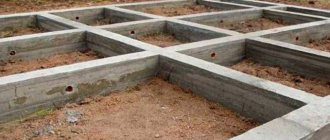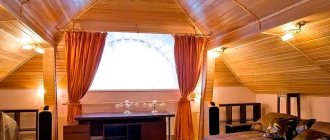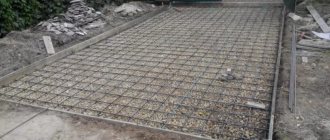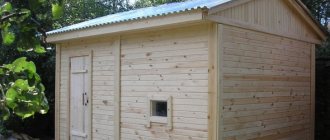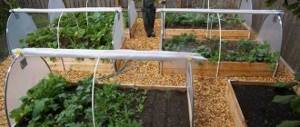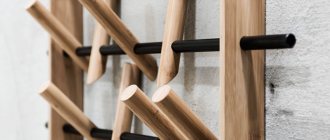A beautiful and comfortable spiral staircase is quite simple and is perfect for organizing the transition to the attic or attic floor.
The most convenient thing is the fact that it can be made from any product without resorting to the services of professionals. Installation of this small part of the design, with appropriate preparation, lasts no longer than one day.
Features of a spiral staircase
The main feature of screw structures is their unusual shape. Externally, the console of the building looks like a petal with rounded edges. The main advantage of the device is significant space savings in the house.
Most often it is placed in a vertical position, without inclined straight steps. Despite the fact that it is not entirely comfortable to walk along such a staircase, the entire structure can occupy only 1 square meter. m.
Spiral staircases made of wood: features
When creating a spiral staircase from wood with your own hands, it is worth paying attention to a number of design features that can either repel the desire for installation or strengthen it.
The advantage of a spiral staircase made of wood is that it fits perfectly into any interior
It is necessary to take into account that:
- The steps are arranged in a spiral, which allows you to take up a minimum amount of space.
- Descending such a staircase may not be safe, and therefore care must be taken to increase this criterion to the maximum.
- The staircase may have slight curves, or it may extend upward in alternating turns.
According to the design, the spiral staircase structures resemble peculiar flowers that gradually open towards the bottom. Some even prefer to install the structure so that each turn extends slightly beyond the other. Wooden spiral staircases are an analogue of metal products, but they look more aesthetically pleasing and help fill the room with comfort and coziness. The main component of the product is the central support, which becomes both a guide and a mounting point for all steps.
Varieties of screw models
The structural part of spiral staircases may differ. The flight of stairs is fixed radially. If you pay attention to the horizontal cut of the screw in the diagrams, you will notice that it can be polygonal or round.
Types of spiral staircases:
- resting on a wall and supporting structure;
- supported by special support posts.
- supported on a fence or curved bowstrings;
- with pinching into the support post.
Advantages and disadvantages
- They do not clutter up the space, so they occupy a minimum amount of free space in the room. They are easy to install in small rooms;
- Provided that high-quality materials are selected and all construction rules are observed, this design has a stylish and modern design, so it can not only be a means of transportation, but also serve as home decoration;
- Compared to other types of staircases, the cost of spiral staircases is much lower, so home owners do not have to overpay for anything;
- The structures can be placed either against the wall or in the middle of the room;
- Marches can be installed with the narrowed side to the main central support or the wide part attached to the wall.
Making a drawing of a staircase
Professionals advise starting to make a drawing with a detailed plan of the first floor and indicating the area where it will be installed. The plan must include the exact dimensions of the opening, taking into account the given scale.
It must contain detailed information about the width, slope, plane of the structure and the thickness of the materials used.
Design calculation
Calculation of parts must be carried out with special care, otherwise errors will result in discomfort and bruises.
The calculation must be carried out according to the following rules:
- According to accepted standards, the minimum step length should be about 150 mm with a height of 300 mm. You should not violate these parameters, as this may result in a decrease in the level of security. Maximum figures vary around 140-160 mm in length and 280-300 in height.
- A significant factor is the angle of inclination. Naturally, the higher this indicator, the less space the staircase takes up. Acceptable values vary from 23º to 45º. The most popular tilt angle is from 25º to 35º. An inclination angle of more than 45º is too sharp, so you can only climb the stairs backwards. But if the slope is less than 23º, it is more logical to install a ramp.
Calculation of steps
For the production of steps, wood with a denser texture is often used - tanned beech. Brittle rocks should be avoided, as they are not able to withstand the high loads placed on them.
The thickness of the finished elements should not be less than 50 mm if the height of the structure should not exceed 2 m. If the height of the structure is increased, then the thickness of the steps should be at least 60 mm. The number of steps is determined by dividing the height of the opening by the rise up.
Moreover, a damaged step must be replaced immediately after the defect appears, otherwise one step may pull other elements with it, compromising the strength of the structure. That is why professionals advise purchasing already planed material.
Drawings of spiral wooden staircases
Due to its efficiency and low cost, wood structures are especially popular. As a plan, you can use ready-made drawings developed by professionals.
Drawings of spiral metal staircases
As for the advantages of this type of device, it is undoubtedly fire resistance, the ability to combine various materials, modern design, ease of installation and durability.
Many modern home owners who follow fashion trends and their homes install spiral staircases not only inside, but also outside.
DIY wooden spiral staircase
Before you start work, you need to prepare materials and tools, as well as make all the calculations.
So, for work we will need:
- wooden boards;
- screws;
- drill;
- level;
- roulette;
- balusters;
- handrails;
- drill;
- metal pipes;
- brackets;
- screwdriver;
- anchor bolts;
- loaches;
- hacksaw.
You need to approach the choice of material for creating a wooden structure wisely, remember the following:
- to make degrees, take hardwood, such as beech, oak or maple;
- for railings and bowstrings, take laminated wood material;
- The pole can be made of wood, stone or iron, but it’s better to take a metal pipe for it, preferably steel.
Making preliminary calculations
Calculations in each individual case of assembling a staircase with your own hands will include different numbers, but as an example we take the following design parameters:
- staircase width – 0.9 m;
- height – 3 m;
- metal pipe diameter – 0.2 m.
Now, based on these indicators, we calculate:
- the total diameter of the structure should be equal to twice the width of the step and the thickness of the pipe, that is, multiply 0.9 by 2 and add 0.2. We get 2 meters;
- We calculate the radius of the circle of a person’s rise to the second floor of the house. To do this, take the sum of half the width of the step and the radius of the pillar. That is, we get the following equation: 0.9/2+0.2/2= 0.55 m;
- The calculation of steps is calculated based on the radius of movement and the width of the step.
Now you need to calculate the height of the steps. This indicator also depends on the person’s height. The calculation is carried out as follows:
- divide the circle into 15 equal parts using radial lines;
- the line defining the height of growth is determined by the height from the first step of the coil to the last. Add another 15 cm to this indicator;
- the height of the turn is calculated with a height of 185 cm, a step thickness of 0.5 mm and taking into account the margin, the turn is equal to 2.05 m;
- calculate the height of the steps in a turn: divide 2.05 by 15, we get 13.67;
- We calculate the number of steps by dividing the height of the stairs by the height of the step.
How to make handrails and steps with your own hands
As we mentioned earlier, you can make wooden steps yourself from durable wood, or you can purchase them ready-made and adjust them to the desired size.
Once they are fitted, they should be finished, sanded, edges rounded and varnished . Then the bushings are attached, with the help of which the steps will be attached to the supporting metal post.
Railing balusters can be made from metal rods, but plastic or glued beams are suitable for handrails. The railings are suitable in the form of rectangular wooden blocks of the size you need.
Assembling a spiral staircase
If we have prepared the railings, ready-made steps and a post for support, we can proceed directly to the actual assembly of the structure. Assembly consists of the following steps:
- staircase fittings, as well as fasteners and bushings, are bolted to the steps;
- each step must be “strung” onto the support pillar;
- install the pole itself in the prepared place;
- attach the support pipe to the floor and ceiling;
- the steps must be placed with a certain overlap of each other and be fixed with bolts;
- attach balusters to the steps;
- Attach the railings to the balusters.
Also, when assembling, consider the following points:
- the base of the metal pole must be located on a solid foundation;
- you can partially fill the base and place special mortgages there to secure the support;
- the support pipe must be bolted to the floor;
- the baluster of the first step should be longer than the others in length and is used as a base on the floor;
- fastening is done on the floor to make the structure more rigid.
How to make a spiral staircase to the second floor with your own hands
Concrete, metal, wood and brick pillars are used to construct the supporting structure. They are attached using elements, bolts and couplings welded to the pipe.
Installation of support
The steps are easiest to attach to a wooden stand. For this, bars, metal corners, etc. are used. The stand must be firmly fixed and able to withstand the total weight of all components and a person with a large body weight.
In addition to this, the main support column must be firmly connected to the lower and upper parts of the structure. The diameter of a wooden or concrete rack should be from 150 to 500 mm or more, while a metal structure should not be less than 50 mm.
Installation of steps
To make it convenient for residents to move, it is necessary to place the axles correctly. Often a frame is installed for them, which is pre-fabricated to fit the final shape. Craftsmen advise using corners and welding the support itself in the form of a straight plate.
You can connect 2 metal profiles together in the form of an inverted T-shaped stand. It is on this that steps can subsequently be placed. This technology allows you to adjust the dimensions of the steps at any time.
Fences and railings
At the last stage, the fence is installed. For stairs of this type, it is performed not only as safety, but also as a decorative element in combination with forged inserts and curved wooden elements. Most often, metal pipes are used as a basis. This design looks quite impressive.
For a wooden structure, it is rational to install balusters made of a similar material. The main difficulty is that it is quite difficult to install rounded railings.
The construction of a spiral staircase is a complex process that requires a serious approach. Often such work is entrusted to professionals, but if residents still want to build a spiral staircase with their own hands, the first step is to design and make all the calculations, and carry out construction work in compliance with all the rules described above.
Features of installing a spiral staircase made of logs
Most often, materials such as oak, larch, and pine are used to make spiral staircases. Initially, work begins with the installation of racks around which stairs and railings will be laid. The racks are fixed using anchor bolts, which have maximum strength and ease of installation. Some craftsmen who prefer to assemble spiral staircases from wood choose a combined model. In other words, one in which both wood and metal are present. This increases the strength and durability of the product.
To install a wooden spiral staircase with your own hands, you need to additionally read the step-by-step instructions
The racks should be installed in such a way that they are at a sufficient distance from the wall, which will allow installation without discomfort.
When installing stairs exclusively made of wood, you need to take care of arranging additional lateral fixation for each step. To do this, stringers are cut out and secured to the wall surface using auxiliary beams. In this case, the structure will be partly of a marching type, with winder steps, but with a sharper turn.
For ease of use of the stairs, you need to take care of the correct location of the axial part of the steps. As a rule, they use metal corners or a support in the form of a straight metal sheet, on which the steps will be installed. Due to such a frame, the staircase will be strong and it is possible to adjust the steps.
If you make a wooden staircase yourself, then the steps can be secured to the axial part using bolts or by combining them with stainless steel. The screw design must necessarily have a guard, as this is not only aesthetically pleasing, but also safety, convenience and increased service life. The most common option is to use a thin metal tube or use forged inserts. It is quite possible to make railings from wood, but most often they will be prefabricated, which is not very safe. The structure is finished using wooden balusters, which gives the staircase an aesthetic and noble appearance.



